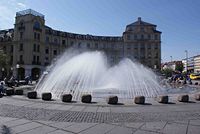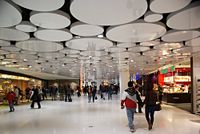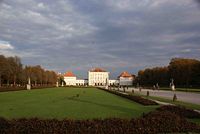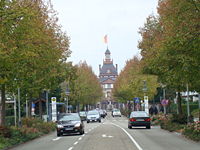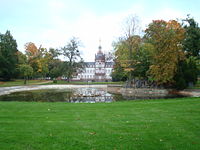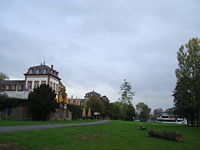Pictures of our Landscapes IMLA Group
---> Back to overview of groups
Fernando Bujaidar Teruel
Images
- Image 01.jpg
image title
- Image 02.jpg
image title
- Image 03.jpg
image title
Description
Please edit your text here..
Author 2: Seah Wei Ping Gabriel
Images
Description
Chinesischer Turm (Chinese Tower)
Located in the heart of the English Garden (Englischer Garten ), Munich, the Chinese tower was built in 1789-1790, as a performance platform. (http://en.wikipedia.org/wiki/Englischer_Garten)
Till today, the Chinese tower still entertained its visitors and guests with traditional music from the brass band and beers from one of the earliest brewery in the region. Housing a spectacular seating space of more than 7000 people, it is set to create an all year round Oktoberfest atmosphere. (http://www.cityscouter.com/travelguides/munich/Chinese-Tower-Chinesischer-Turm.html)
As one of the most frequently visited attractions in Munich, the Chinese tower is a popular social gathering space, both for the locals as well as foreigners. Together they drink; chat, sing and dance, under the Chinese tower in the English garden of Munich, Germany. To find such a Chinese pagoda in such context is ironic, but nevertheless, it provides the vast park with a distinctive landmark. Which otherwise would be a real challenge for the visitors to find their ways or even to set a place for meeting.
Also the language of the Tower narrates the possibilities that cultural influence of the Chinese once swept across this land. Creating immense fascination that inspired Architects to construct a 25 meter high tower in the middle of a European city.
Although the Chinese architecture physically dominates the space, the local culture remains as the soul of the place. In other words, the actual atmosphere is still formed and shaped by the Bavarian living habits and lifestyle.
Marienplatz(Munich City Centre)
Known as the city centre of Munich, it served as an important public square to the city since 1158, hosting various important social events. (http://www.aviewoncities.com/munich/marienplatz.htm)
Today the square is dominated by the gothic style architecture of the new townhall, built in 1867 - 1909, it was the solution to the overcrowded old townhall back then. (http://www.aviewoncities.com/munich/marienplatz.htm)
Inhabited by shops, traditional restaurants, souvenir kiosks and the fact that it is the old city square, Marienplatz earned itself the title as a ‘must visit place’ in numerous travel guides . However, these are the only reasons which explain the thousands of people visiting daily.
Well connected to more than 3 busy subway stations, all within comfortable walking distances. Like our vital body system, they depict the arteries to the heart, making circulations through the square natural.
Besides that, varieties of businesses and activities flood into the square, resulting in a lively and vivid atmosphere, which is able to attract and retain the crowd. These also act as a relief to the network of busy streets, creating a pause to the dynamism.
One clear example of the effect can be seen daily during the 1100, 1200, and 1700 hours. At this time of the day, figurines within the famous Glockenspiel perform 2 traditional stories dated back in the 16th century, entertaining the hundred of audiences in front of the gothic facade for a whole quarter of an hour. (http://en.wikipedia.org/wiki/Rathaus-Glockenspiel)
Marienplatz was of course not spare from modernisation but despite the increase of modern shop fronts and contemporary architecture languages, traces of the past are still highly visible and significant. Historical buildings, old streets paving and even old town drainages are retained. Therefore, the possibilities of the experiencing old city charm of Munich today.
The Hofgarten (Court Garden)
An Italian renaissance Garden in the centre of Munich, Germany. It is located between the Residenz and Englisher Garten (English Garden). Within the garden are series of pathways, organized in a formal manner, creating a symmetrical layout. Positioned in the middle of the garden is a pavilion, dedicated to the goddess Diana. Further suggesting its importance, eight paths were directed towards the pavilion, forming a focal point in the landscape.
Created by the symmetrical walkways, voids in between the paths were carpeted with lawns. These lawns provide recreational spaces for socialization and relaxation.
While in the Hofgarten, one can experience the unique spatial experience of being in a formal garden enclosed by significant buildings and monuments. It is thus, also a quiet getaway from the busy city streets.
( http://en.wikipedia.org/wiki/Hofgarten_(Munich))
Author 3: Carla E.Tosso
Images
'IMAGE 1: Karlsplatz (Stachus)'
Karlsplatz or most commonly known as Stachus(1) is an iconic Fountain that marks the beginning of the pedestrian zone of the center of the city. This axis also leads to the well-known centre of the city or Marienplatz, the beginning of this axis is clearly marked with the old western door of the city named KarlsTor(2.
This entrance is very important, you can clearly feel that the environment changes with a lot of shops, coffee places and bars along the way, the people in Munich enjoy this spaces on a daily basis for a stroll with their families, having a drink or a shopping spree.
The buildings surrounding Karlsplatz towards Marienplatz have a great architectonic value even though this buildings have certain high, you never feel enclosed or dominated by them they have a very good merge with the existing vegetation and the architectural elements as churches, offices and business that you find along the way, the vegetation that exist consist mostly of trees along the way, these provide confortable shade in summer and are part of the environment which are very important for the people that relate to nature in several ways as parks and open spaces.
The most important thing about Karlsplatz that is an important reference point of the city, and is used as a space to start your day or simply sit there and enjoy a drink and look at the surroundings.
Media:(1) http://en.wikipedia.org/wiki/Karlsplatz_(Stachus)
Media:(2) http://www.munich-info.de/portrait/p_karlstor_en.html
Author 4: Adham Momtaz
Images
- .jpg
image title
- .jpg
image title
- .jpg
image title
Description
Please edit your text here...
Images
- Image 01.jpg
image title
- Image 02.jpg
image title
- Image 03.jpg
image title
Description
Please edit your text here...
Author 6: Giselle Gurgel and Suranjana Datta
Images
Description
Schloss Phillipsruhe (Phillipsruhe Castle) in Hanau, Germany was built by the Count Phillip Reinhard and its construction began in 1701. Located in Kesselstadt, to the west of the city of Hanau, it is on the bank of the river Main. The castle serves as a museum in its main building since 1967, showcasing different aspects of local history.It's garden is also host to seasonal horticulture shows and cultural shows including the Brother Grimm Fairytale festival are experienced in the amphitheatre in the castle park.(1)
The Phillipsruher Allee (Phillipsruhe Avenue), which runs along the river, has the castle as its focal point. This major axis continues in the castle garden, signifying the importance of the castle which is placed centrally on its large and flat ground. This geometry of the road and the garden is influenced by the presence of Schloss Phillipsruhe.
The high wall running along the boundary of the castle grounds confines its landscape within the boundary, with no connections to the river which flows to the right of the castle. The man made water body behind the castle with no association with the river illustrates on the attempt which was made to glorify monarchy and the monarch’s dominating and manipulating character to show his authority, wealth and power over nature.
Since Hanau required more recognized recreation places in the city, the ‘’Aue’’ (floodplain and natural form of vegetation along streams and rivers) of Main serves for sports, children’s park and other outdoor activities. Although this Aue includes in its area the land between the castle wall and the river, and these places are physically connected, they are visually not connected. This area with this new use: new needs of recreation for the city’s people, contrasts with the old and authoritative representation that the castle projects.
The different pictures show three different aspects of the castle, but all of them are connected by the importance that it and its owner had projected. The castle is strategically placed both in terms of waterways and roads; as a direct focal point of the road or as a powerful image seen from the river. On the other hand, the landscape garden along with the water body in the castle grounds was created for a more private use of the owner, for him to appreciate his own grandiosity and acquirements.
(1). Source - http://de.wikipedia.org/wiki/Schloss_Philippsruhe, http://www.hanau.de/kultur/museen/index.html
Author 7: Balázs Dukai
Images
- .jpg
image title
- Image 02.jpg
image title
- Image 03.jpg
image title
Description
Please edit your text here...
Author 8: Nemanja Markovic
Images
Description
As an answer to our first assignment, 'Pictures of your Landscapes', I was mainly focusing on social aspect of Munich landscape. These pictures represent my view of what is unique and special about the way Munich residents spend their free time. In a way they also speak about people's passion, their habits and lifestyle.
Even though Munich residents, in other parts of Germany were known for their very conservative and religious lifestyle, now it seams different. As far as I could notice their free time is more oriented towards, drinking bear, having fun, doing sport and spending a lot of time in nature.
In each one of these photos you can see connection between people, nature, sport, and beer.
- First picture represents people’s devotion to nature; it is about people’s lifestyle.
Nature is a part of everyday life here in Munich. There are many parks and gardens such as: Olympiapark, Westpark, and the parks of Nymphenburg Palace. In Hirschgarten for instance, besides having fun in healthy green environment you can actually see free deer that live there, even though the garden is considered to be in urban environment. English Garden is one thing that makes Munich such a pleasant city to live in. During the summer you will see students from the adjacent university studying here. Other people play football, Frisbee, horse riding, play cricket and surfing on the Eisbach river! Particularly notorious activity is sunbathing in the nude. In the area in and around the horse track (near University) it is permitted to strip off naked. In Germany this is called FKK (Frei Körper Kulture = Free Body Culture).
The Munich English Garden is a huge park which stretches alongside the river Isar from almost the very center to the northernmost rim of the city. English Garden was created in 1789 by the British physicist Sir Benjamin Thompson, the count of Rumford. Park covers 3.73 square kilometers which makes it the largest city park in Europe and larger than New York's Central Park (3.4 square kilometers). [1]
- Second picture represents people’s passionate relations to sport.
The most popular sport in Munich is football for sure. Two of the world largest stadiums are located in Munich (Munich Olympiastadion and Allianz Arena) and together can host more then 135.500 spectators. Allianz Arena hosts Bayern München football team; their fans are known to be very passionate and cheering. But on the picture you can see surfers. They surf on Eisbach river that floats thru Englisher Garten. Even though when I think of surfing the first thing that pops into my mind are Hawaii or similar exotic islands, these enthusiastic young people proved me wrong. Considering the fact that middle European climate is not always very supportive to this kind of activity, I was quite impressed by their skill and passion, so I had to present them instead of football fans.
- Third picture represents ordinary common people in a beer garden who drink bear, have fun, talking to each other, chatting and telling jokes.
Beer garden is an open-air area where beer, other drinks and local food are served. It is usually attached to a drinking establishment such as a public house or a beer hall, which in places such as Munich may serve large numbers of customers. The biggest beer garden is in Hirschgarten it can serve up to 8,000 people. [2]
Author 9: Please write your name here
Images
- Image 01.jpg
image title
- Image 02.jpg
image title
- Image 03.jpg
image title
Description
Please edit your text here...
Author 11: Please write your name here
Images
- Image 01.jpg
image title
- Image 02.jpg
image title
- Image 03.jpg
image title
Description
Please edit your text here...
Author 3: Please write your name here
Images
- Image 01.jpg
image title
- Image 02.jpg
image title
- Image 03.jpg
image title
Description
Please edit your text here...
Author 12: Please write your name here
Images
- Image 01.jpg
image title
- Image 02.jpg
image title
- Image 03.jpg
image title
Description
Please edit your text here...
Author 13: Please write your name here
Images
- Image 01.jpg
image title
- Image 02.jpg
image title
- Image 03.jpg
image title
Description
Please edit your text here...



